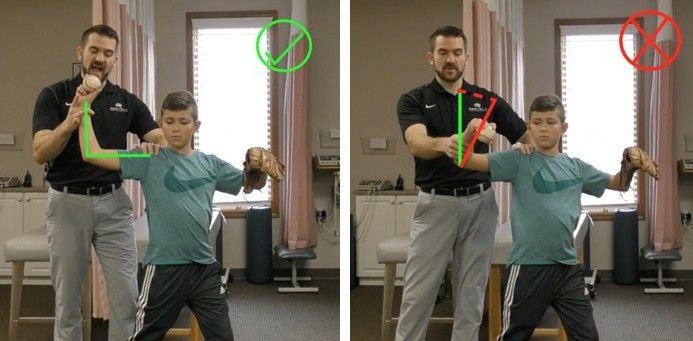Treatment Of Little League Elbow: 3 Expert Tips
In today’s blog, Dr. Tyler White of Gestalt Performance provides three of the most common pitching mechanic flaws that lead to elbow injury. In the next five minutes, you will learn how these three throwing patterns cause elbow injuries.
The 3 Most Common Movement Flaws in Throwing Athletes
1. The Late Arm
Upon foot strike, the throwing arm should be near 90 degrees of humeral flexion, abduction, and external rotation. If the elbow is less than 45 degrees of external rotation, then excess medial elbow stress will occur upon arm acceleration.
2. Early Trunk Rotation
Injury-free pitching requires the transfer of force from the ground, through the body, and ultimately to the baseball. Fifty percent of ball velocity is the resultant force accumulated during the stride and trunk rotation. Efficient trunk rotation occurs once the front foot in on the ground. Otherwise, there is a break in the kinetic chain requiring the pitcher to generate excess torque through the shoulder and elbow. (1)
3. Pronated Forearm
Forearm pronation increases the strain placed on the flexor mass of the elbow. Repetitive stress to the wrist flexors leads to the progression of little league elbow. Youth pitchers should keep their hands behind the ball and not allow the ball to face second base. Hand positioning, rather than pitch type, will directly affect the amount of torque placed on the elbow.
“A late arm and early truck rotation will double the stress at the elbow during the throwing motion.” -Dr. White
Clinical Pearl
One key factor in injury prevention for baseball players falls outside of the pitching mechanics. Deceleration forces of overhead throwing reach 1.5 times the body weight applied to the rotator cuff. (1) These muscles, specifically the infraspinatus, may need up to 4 days to recover. (2)
Overspecialization in youth sports is here to stay. Repetitively stressing underdeveloped tissue is now culturally acceptable and almost expected in top-level athletics. Overhead-throwing sports are no exception. Skeletally immature athletes regularly develop structural adaptations to their elbows and shoulders, possibly improving their performance in the long run if adequately managed. Unfortunately, coaches and parents may not manage these elite athletes appropriately. When pitch counts increase and rest days decrease, many youth baseball players become our patients.
Wouldn’t it be great to have all of this information in one concise protocol that you can access 24/7 and use to educate your patients in seconds?
Well, with ChiroUp, you can.
You will also have access to our protocol for Little League Elbow and 98 other conditions.
ChiroUp exists to make you the top provider in your community. This is the year to take your practice to new heights, and we want to be there along for the ride! See how ChiroUp makes this happen, and try your first 14 days FREE.
-
Toyoshima S, Hoshikawa T, Miyashita M, et al. Contribution of the body parts to throwing performance. Biomechanics IV. Blatimore, University Park Press, 1974;169–174 Link
Fleisig GS, Andrews JR, Dillman CJ, Escamillia RF. Kinetics of baseball pitching with implication about injury mechanisms. Am J Sports Med. 1995;23:233–239. PubMed doi:10.1177/036354659502300218 Link
Pexa BS, Ryan ED, Hibberd EE, Teel E, Rucinski TJ, Myers JB. Infraspinatus Cross-Sectional Area and Shoulder Range of Motion Change Following Live-Game Baseball Pitching. Journal of sport rehabilitation. 2019 Mar 1;28(3):236-42. Link


